Tim has recently written an article for or the Summer 2021 edition of Exmoor Magazine on the important modernist painter and potter Waistel Cooper.
View our available selection of Waistel Cooper ceramics here
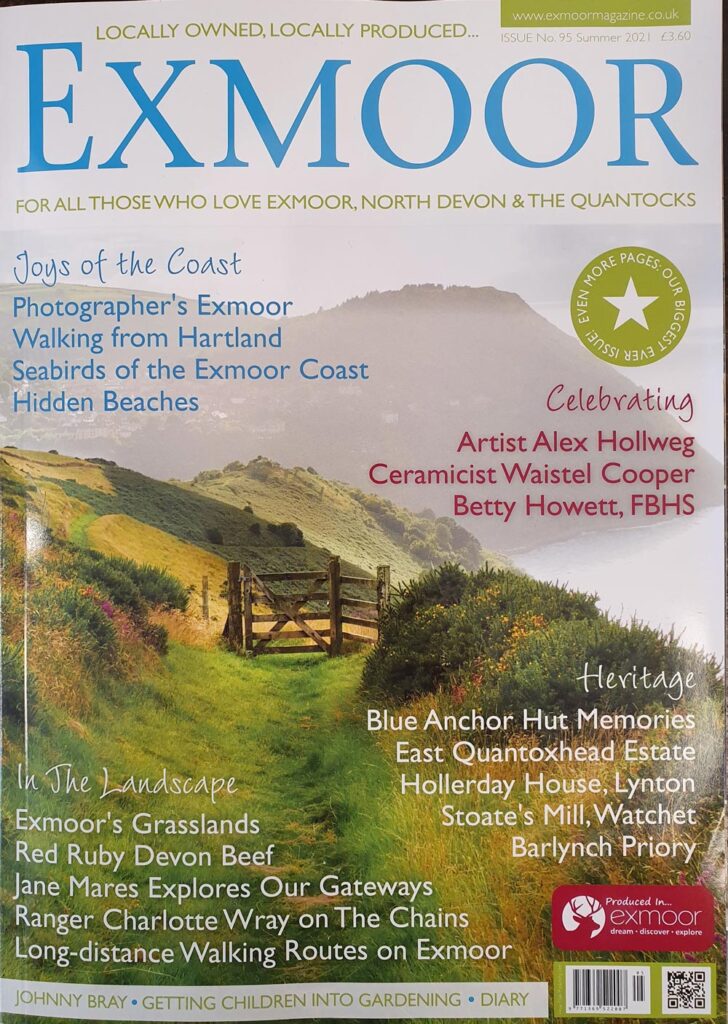
Tim has recently written an article for or the Summer 2021 edition of Exmoor Magazine on the important modernist painter and potter Waistel Cooper.
View our available selection of Waistel Cooper ceramics here

The demand for modernist studio potter Waistel Cooper’s work has seen prices dramatically increase in auctions and galleries over the past few years. The Antiques Trade Gazette recently ran an article about this and reached out to Tim for comment.
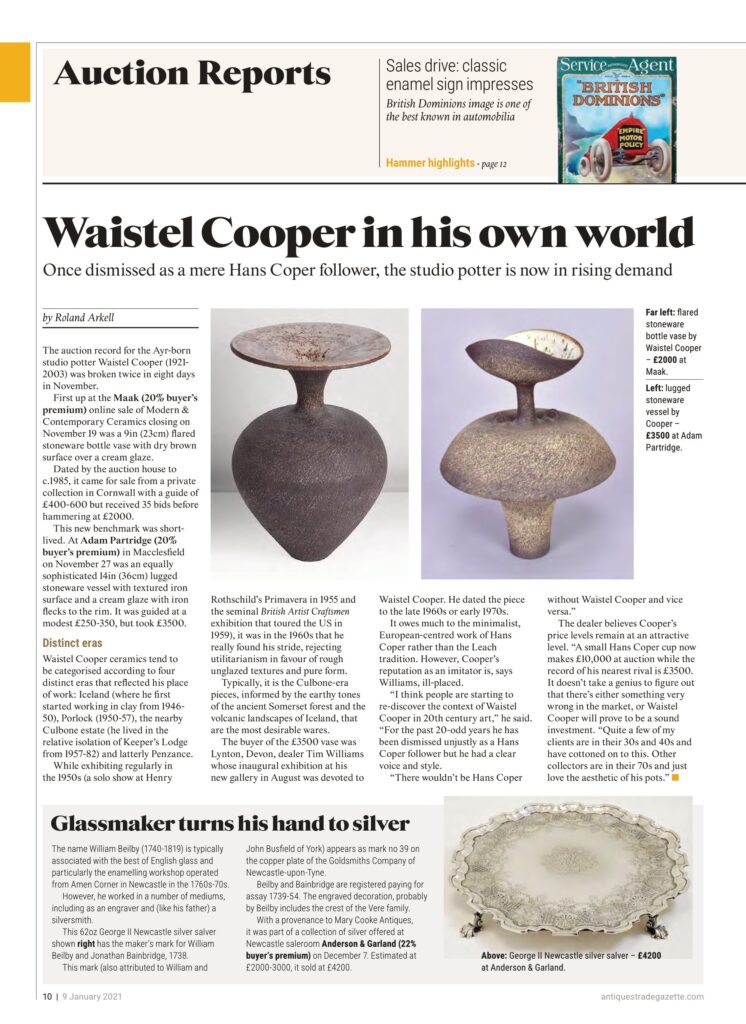

Tim Williams Fine Art are excited to announce their first print release with photographer Richard Ansett.
The prints will be available to purchase via www.timwilliamsfineart.com or email tim@timwilliamsfineart.com for any enquiries.
Grayson Perry: Big American Road Trip #1 and Grayson Perry: Big American Road Trip #2 are an edition of 8 prints. Printed on archival pigment print, Hahnemühle FineArt Pearl paper 285gsm, measuring 100 x 77.4cm, with accompanying certificate of authenticity, embossed and editioned by the artist.

The prints are photographic portriats of the celebrated British artist Grayson Perry as his female alter-ego Claire. The two photographs were created for the Channel 4 documentary series Grayson Perry’s Big American Road Trip which premieres on the 23rd September at 10pm. The series will see Grayson Perry travel across the United States of America on his custom Harley-Davidson motorcycle, in an attempt to explore the meaning of the American Dream today.
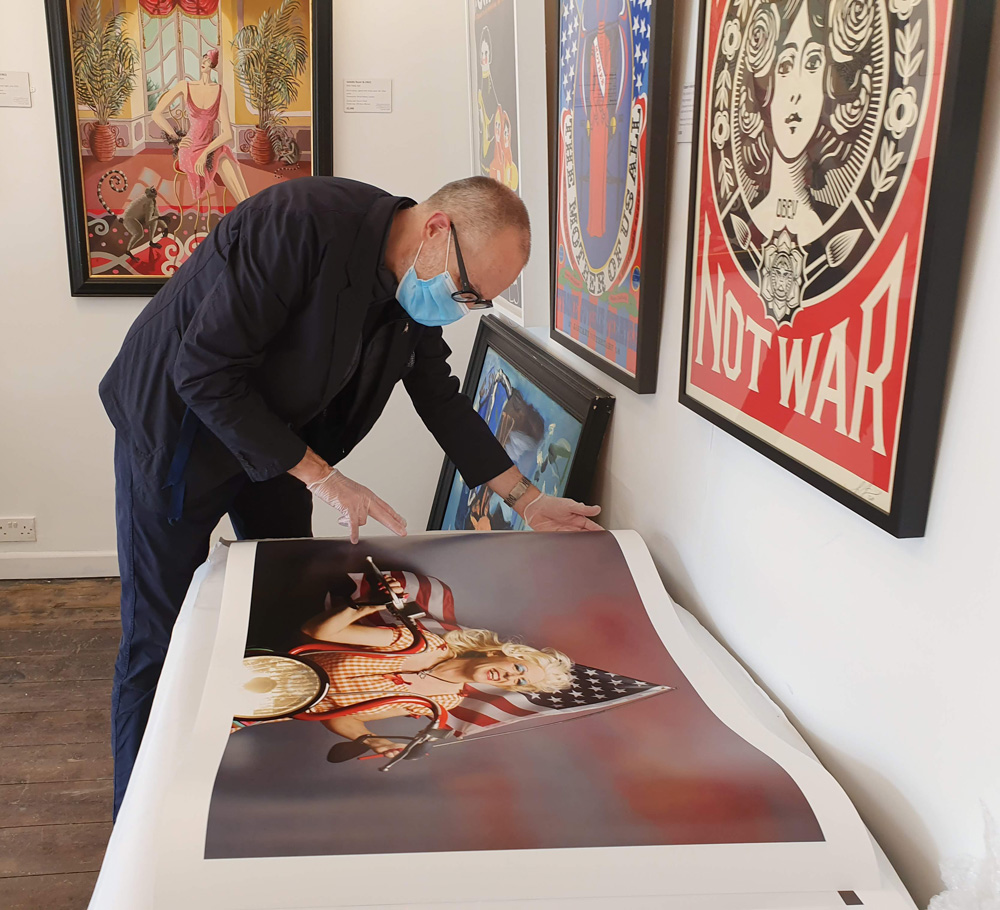
Richard Ansett (born 20 February 1966) is an award winning photographer known for his provocative and thought-provoking images. Richard has a long established collaborative working relationship with the artist Grayson Perry, he has worked with Perry ever year since 2013 developing photographic strategies to promote Perry’s documentaries of contemporary British life. This relationship yielded the exhibition ‘Birth’ at London’s Fitzrovia Chapel in 2019, and more recently has resulted in these stunning promotional images for the forthcoming Channel 4 documentary Grayson Perry’s Big American Road Trip. The three-part series will be broadcast on Channel 4 on the 23rd September at 10pm. Alongside the documentary ‘Grayson Perry: The MOST Specialest Relationship’ – an exhibition inspired by Grayson’s travels across the USA is being held at the Victoria Miro Gallery.
Richard Ansett’s achievements in the world of photography are considerable. His works can be found in prestigious permanent collections including the National Portrait Gallery, London, the National Library and Archives Canada, Bibliothèque Nationale de France and the Smithsonian Institution. He has won countless photography awards including 1st Prize at the Sony World Photography Awards 2019, People’s Choice Award, Taylor Wessing Portrait Prize 2018/19, 1st Prize Moscow International Foto Awards 2014, Overall Winner Art Laguna Prize ’13, 1st Prize Grand Prix de la Decouverte ’13, Gold Award – Prix de la Photographie ‘11.
For further reading, Richard’s interviews with the National Portrait Gallery and the Guardian newspaper provide a good insight into his methods, approaches and creative process.
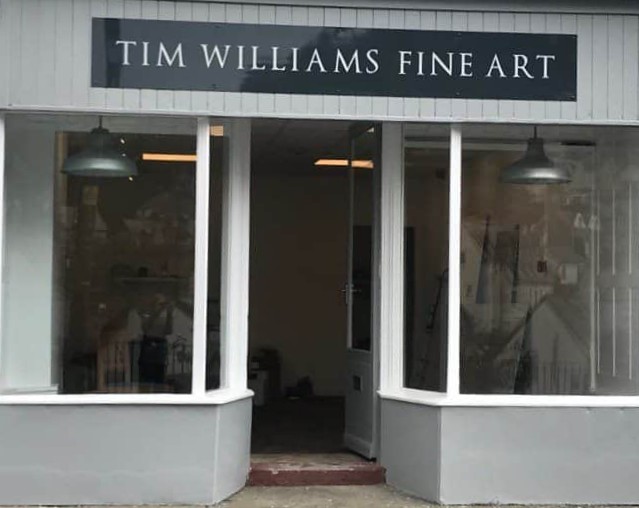
We’ve been busy painting, sanding, building walls and will be hanging the first picture in our new Lynton Gallery imminently. We are opening on the 1st August with a Waistel Cooper studio pottery exhibition, running alongside our collection of paintings, prints and fine furniture.
Lynton is one half of the picturesque villages of Lynton & Lynmouth on the North Devon Coast, within the Exmoor National Park – an area noted for its outstanding beauty. Although not renowned for as a major centre of British art, Lynton & Lynmouth has an artistic heritage to rival the more well known coastal towns of Staithes, Newlyn and St. Ives. The natural beauty of the landscape has attracted artists to the area since the 18th century, including J.M.W. Turner, Samuel Palmer, Thomas Rowlandson, Albert Goodwin, Conrad Martens, Frederick John Widgery, Francis Nicholson, Sir Alfred Munnings, Harry Phelan Gibb, Ethelbert White, Ford Maddox Brown, John Anthony Park, Ann Le Bas, Waistel Cooper, Fred Hall and Damien Hirst. Our new Lynton gallery aims to explore that rich artistic heritage through exhibitions and publications.
As well as offering a wide selection of fine art, we also offer valuation services as well as advice on building and disposing of collections.
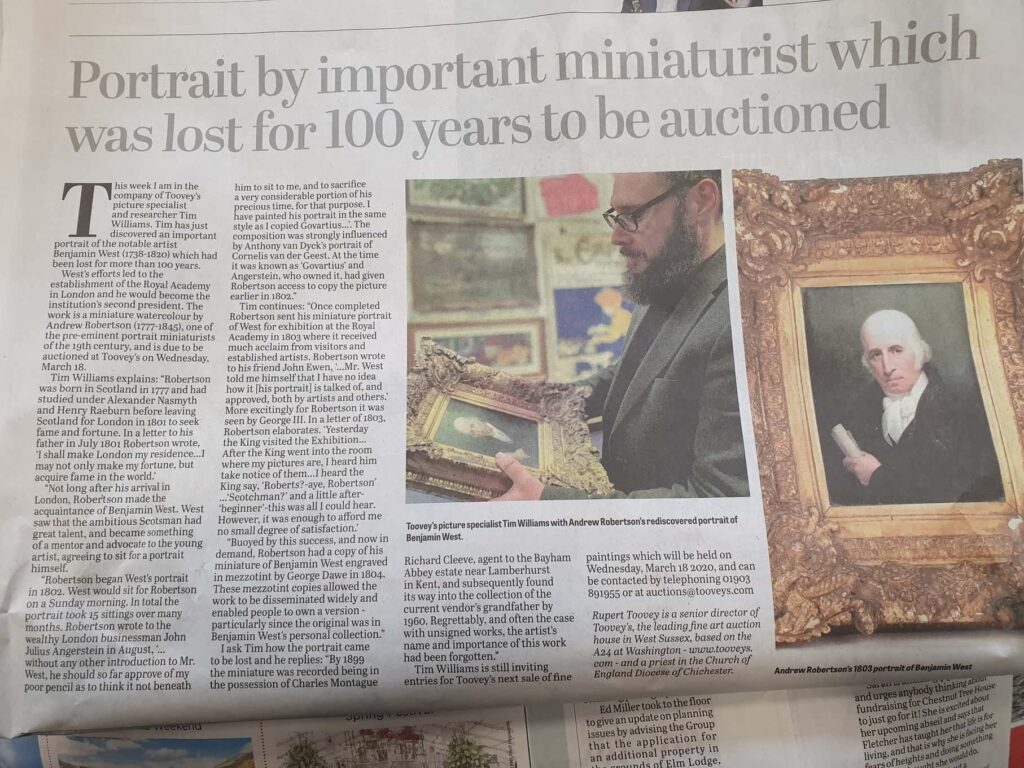
I was thrilled to have ‘re-discovered’ Andrew Robertson’s important portrait of Benjamin West earlier this year. The story was published in the West Sussex Gazette (above).
Benjamin West
Benjamin West PRA was an American artist, who painted famous historical scenes such as The Death of Nelson, The Death of General Wolfe, and Benjamin Franklin Drawing Electricity from the Sky. Entirely self-taught, West soon gained valuable patronage, and he toured Europe, eventually settling in London. West became one of the most celebrated artist’s of the age, and was elected to the prestigious position of President of the Royal Academy of Art, an insitution he helped to establish. His work was greatly admired by the King, George III who appointed Benjamin West historical painter to the Court and Surveyor of the King’s Pictures.
Andrew Robertson
Andrew Robertson was born in Aberdeen in 1777. He was the brother of Alexander and Archibald Robertson, who were also painters.
Robertson created a new style of miniature portrait that became dominant by the middle of the nineteenth century; at least four examples are held in the Victoria and Albert Museum. He broke with previous styles, particularly the work of Richard Cosway, and was critical of these earlier painters, describing their works as ‘pretty things but not pictures’. Robertson’s style included larger and more detail paintings, usually rectangular, and with a use of paint trying to emulate large oils on canvas, adding more gum to the paint to give it a greater lustre and depth of colour. Andrew Robertson’s work as a miniaturist led him to portray a number of notable figures of his era, the most celebrated of which was his portrait of the President of the Royal Academy Benjamin West. Andrew Robertson’s own self-portrait hangs in the National Portrait Gallery, London.
View our stock of fine paintings and prints.
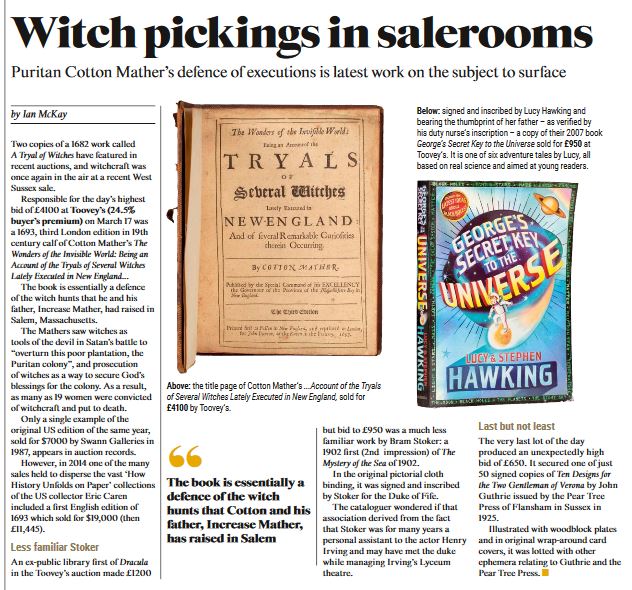
Salem Witch Trials Book
Late last year I responded to an advert on a local ‘items for sale’ Facebook group advertising a collection of books for sale that were housed in a barn on Exmoor. I had spied a couple of volumes of The Studio in one of the images, and arranged to view the books at a convenient time. On viewing the collection, the owner passed me a small leather bound book, and I nearly fainted when I opened the cover. It was a copy of Cotton Mather’s Tryals of Several Witches Lately Executed in New England published in 1682 – a book published about the Salem Witch Trials. I advised the owner to sell the book at auction, where it sold for £4,100 in March – a few days before lockdown. The result was published in the Antiques Trade Gazette (see image above).
Due to our connections with leading auction houses we can negotitate more favourable rates of your behalf, so if you have any antiques or fine art that you wish to dispose of please don’t hesitate to get in touch. Discover our stock of Fine Art and learn more about the services we offer at www.timwilliamsfineart.com
We are delighted to have been appointed an agent for Patrick Hughes Rainbow prints. A wide selection is available on our website. Trade enquiries welcome, please feel free to email us tim@timwilliamsfineart.com
Born in 1939, Patrick Hughes lives and works in London. Widely recognised as one of leading British Artists of the 20th century, he was at the vanguard of the Pop Art movement in the early 1960s. He was the first British Pop artist to receive a solo exhibition in London in 1961 at the Portal Gallery. At the invitation of Richard Hamilton, Hughes’s screen-print ‘Brick Door’ was included in the seminal portfolio published by the Institute of Contemporary Art in 1964. This ground-breaking portfolio featured the screen-prints of 24 notable artists: Patrick Caulfield, David Hockney, Howard Hodgkin, Sir Peter Blake, Robyn Denny, Joe Tilson, Bridget Riley, Sir Eduardo Paolozzi, Victor Pasmore, Harold Cohen, Gordon House, Richard Smith, Bernard Cohen, Gillian Ayres, Derek Boshier, Gwyther Irwin, Peter Phillips, William Turnbull, and Allen Jones. For many of the artists, it was their first experience of print-making, including Hughes, Hockney and Caulfield, all of whom became leading proponents of the medium.
During the 1970s, Patrick Hughes started exploring the ‘rainbow’ motif in his printed works, a theme he has explored through various editions of Rainbow Prints. Through these popular and iconic prints as well as his explorations in perspective or ‘reverspective’, he has cemented his place in the pantheon of great 20th century artists.
His work can be found in major public collections worldwide, including the Tate Gallery, London; Institute of Contemporary Art, London; Museum of Fine Arts, Boston; Denver Art Museum; The British Library, London; the British Academy; London; the Gallery of Modern Art, Glasgow; Victoria & Albert Museum, Manchester City Art Gallery; Würth Museum, Künzelsau, and the Baker Museum, Florida.
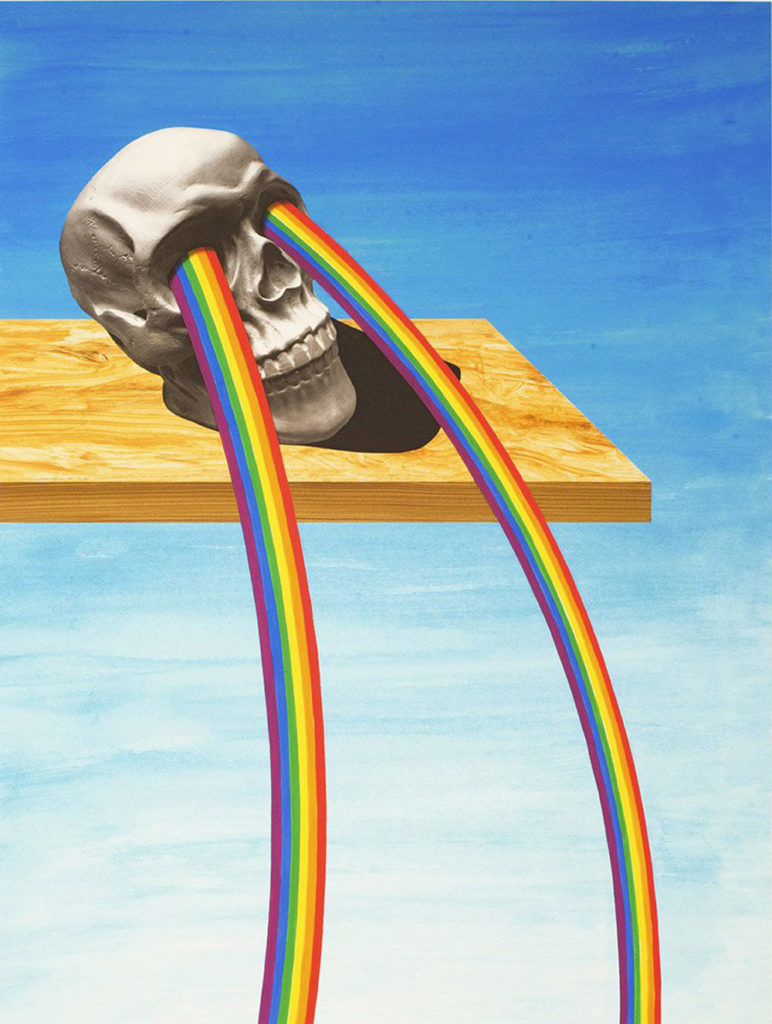
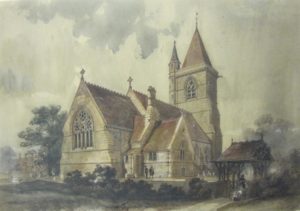
There is a good deal of recorded history and anecdote regarding both the church and the execution of the perspective watercolour. The church was built from the funds of Roundell Palmer, 1st Earl of Selborne who gives an account of how he came to employ Waterhouse as Architect in Memorials Part 2 Personal and Political:
One of my earliest resolutions, after taking possession of our new home, was to build a church in that lower part of Selborne in which Blackmoor was situated, and to have the district made into a new parish. In the prosecution of that object I was aided by Frederic Parsons, then Vicar of Selborne, who in the early days of my connection with Magdalen College, had been tutor there, and was a good scholar, and a man of many accomplishments. He had, indeed, the best reason to know that such a subdivision of his parish was wanted. There was in that part of it which would naturally form the new district, a population of about 700, scattered in small clusters of houses, with only one considerable hamlet. That work was taken in hand soon after my residence at Blackmoor began. Mr. Alfred Waterhouse was my architect. I had been brought into communication with him over the plans for the new Courts of Law, and both liked him personally, and thought highly of his professional work. The church, which now stands at a distance of ten minutes’ walk north of our house, was built from his plans, and under his superintendence, by local masons and my own carpenters. This, and the building of a vicarage and schools and some more cottages, took the best part of three years. All the lower part of Selborne, in extent the larger part, was made, for ecclesiastical purposes, the new parish of St. Matthew, Blackmoor ; and the Church was consecrated on the 18th of May 1869. Bishop Claughton preached the sermon; and many of our most attached friends were present. On the day before we gave a dinner to the workmen and to a large body of the tenant farmers and labourers. In addressing them, I said, speaking-then, if ever, from my heart “Most men, at some time of their lives, desire to do some work which shall last after them, and which shall help those among whom they live when they themselves shall have passed away. And from the bottom of my soul I hope and pray that this undertaking, to be inaugurated (we trust) to-morrow, may prove to my children and my children’s children, and to generation after generation of their neighbours, the inhabitants of this place, a real and ever-increasing blessing.” It was a happy day.
The biographer of Waterhouse, Colin Cunningham, gives further insight to the execution of the perspective view:
..at St Matthew’s Blackmoor, where Waterhouse charged 2.5 days of his own time on the perspective, it was not done until 1870 when the church was well under way. There are therefore good grounds for accepting that many of the fine perspectives were drawn more as aids to the appreciation of how an agreed design would appear than as part of the sales pitch. The great perspectives may have been attractive to clients, but as works of art. A number were hung in the boardrooms and committee rooms of the buildings themselves.
So how did the watercolour drawing end up in private hands? Waterhouse submitted one of the perspectives to The Royal Academy exhibition of 1870 – exhibited as number 792 ‘St. Matthew’s, Blackmoor’ and attracted the following critique from The Athenaeum:
Mr. A. Waterhouse’s St. Matthew’s, Blackmoor has much of the architect’s grace and spirit, yet it is slightly mannered.
It seems logical that the perspective was purchased from the exhibition at the Royal Academy and after a series of events eventually ended up in my possession. Regrettably the previous owner(s) have not cared for it very well, as it has suffered the from the effects of being hung close to a source of natural light, causing some fading of the colour pigments and discolouring of the paper, though some of this can be righted by a skilled conservator.
The perfect outcome for me was to reunite the watercolour with the family who commissioned both the church and architect, over one hundred years later.
Be the First to Hear About New Stock, Exhibitions, Offers and Events.